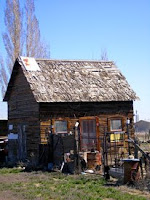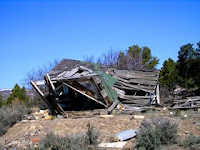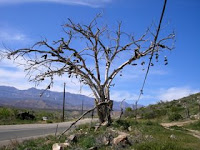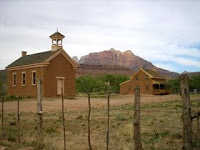
From Price we set out on our last travel day with the Utah/Nevada border town of Mesquite as our final destination. Though a long mileage day, the driving's easy, as the vast majority is on the interstate. Heading south out of Price on NV-10 we detour west at NV-122 in search of two more Carbon County mining camps - Hiawatha and Wattis. Unfortunately, this is a bust, as Hiawatha is on private property and nothing remains of Wattis other than active coal mining. Oh, well, it's all part of the adventure.
 We backtrack back to the highway and head south again towards I-70. We take a short detour south of Huntington, eastward a few miles to the small farm settlement of Lawrence. Here, we see a few crumbling buildings in various states of disrepair, but most of this little burg is still occupied by farmers.
We backtrack back to the highway and head south again towards I-70. We take a short detour south of Huntington, eastward a few miles to the small farm settlement of Lawrence. Here, we see a few crumbling buildings in various states of disrepair, but most of this little burg is still occupied by farmers.  Returning to NV-10, we soon come to Emery, a semi-ghost town. Though still occupied by about 300 people, the town is but a shell of its former self and from what we could tell, only had one open business plus the post office. Interspersed throughout the well-cared for homes, were a number of tumbling barns, an 1898 church, a few closed businesses and a several interesting abandoned old houses.
Returning to NV-10, we soon come to Emery, a semi-ghost town. Though still occupied by about 300 people, the town is but a shell of its former self and from what we could tell, only had one open business plus the post office. Interspersed throughout the well-cared for homes, were a number of tumbling barns, an 1898 church, a few closed businesses and a several interesting abandoned old houses.  Continuing southward, Dave is ecstatic when we hit the interstate, and its 75 mph speed limit. At the junction of I-70 and I-15, we make a stop at Cove Fort. Not a military fort, but rather a Mormon rest stop, the fort was established for the protection and refreshment of travelers in the mid 1800's. However, the fort was never needed for protection against the Indians as the Hinkley family, which built and lived at the location were on good terms with the Paiute. Only one shot was ever fired at the fort and that was accidental. Restored and maintained by the Mormon church today, the site includes the enclosed fort, telegraph office, stage stop, and living quarters. It also includes a barn, bunkhouse and blacksmith shop.
Continuing southward, Dave is ecstatic when we hit the interstate, and its 75 mph speed limit. At the junction of I-70 and I-15, we make a stop at Cove Fort. Not a military fort, but rather a Mormon rest stop, the fort was established for the protection and refreshment of travelers in the mid 1800's. However, the fort was never needed for protection against the Indians as the Hinkley family, which built and lived at the location were on good terms with the Paiute. Only one shot was ever fired at the fort and that was accidental. Restored and maintained by the Mormon church today, the site includes the enclosed fort, telegraph office, stage stop, and living quarters. It also includes a barn, bunkhouse and blacksmith shop. Unlike another stop we made a couple of years ago at the Liberty, Missouri Jail historic site, which was also run by the church, we did not receive a lot of pressure from the very kindly couple that took us on a tour of the fort. In fact, it was very interesting and we much enjoyed it. Unfortunately, on that other stop we made a couple of years ago, we were so surrounded by aggressive church recruiters, that I never even wrote about the place. Maybe, I'll rethink that and write about its history, as it is very interesting. Unfortunately, at the time, I was just so repulsed by the pressure, that unfortunately, I didn't want to "promote" the site. If this has been your experience at other Mormon sites, don't let it stop you at Cove Fort, as it is well worth the stop.
 Onward south we "fly" down I-15 to Cedar City, where we veer off once again headed westward down UT-156. We take a short detour at the ruins of Old Irontown, where the Union Iron Company thrived from 1868 to 1877. Once supporting some 100 residents, the site had a foundry, machine shop, brick schoolhouse, blacksmith shop, pattern shop and several homes. Today, the remains of the furnace, a cone-shaped kiln, and one home can still be seen at the state operated site.
Onward south we "fly" down I-15 to Cedar City, where we veer off once again headed westward down UT-156. We take a short detour at the ruins of Old Irontown, where the Union Iron Company thrived from 1868 to 1877. Once supporting some 100 residents, the site had a foundry, machine shop, brick schoolhouse, blacksmith shop, pattern shop and several homes. Today, the remains of the furnace, a cone-shaped kiln, and one home can still be seen at the state operated site.  We then head south down UT-18 in search of the Mountain Meadows Massacre site. Here, in September, 1857, the Fancher-Baker emigrant wagon train from Arkansas was attacked by the Mormon Militia, with the aide of local Paiute Indians. After a five day siege, an estimated 120 unarmed men, women and older children were killed; 17 of the younger children under the age of seven were spared. Remembering the history and paying our respects, it was a very sad site, but well worth the stop.
We then head south down UT-18 in search of the Mountain Meadows Massacre site. Here, in September, 1857, the Fancher-Baker emigrant wagon train from Arkansas was attacked by the Mormon Militia, with the aide of local Paiute Indians. After a five day siege, an estimated 120 unarmed men, women and older children were killed; 17 of the younger children under the age of seven were spared. Remembering the history and paying our respects, it was a very sad site, but well worth the stop. The rest of our journey southward back to I-15 is very picturesque as we pass by mountain farms, streams and lakes. Landing for the night in Mesquite, Nevada, our journey is officially over. Tomorrow, it is a straight shot to the Las Vegas airport and we are homeward bound. Stay tuned, as I get all these stops and their history written up in detail.
Happy travels!!









 Cisco
Cisco





















